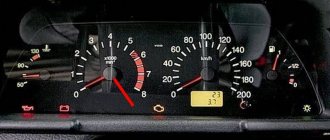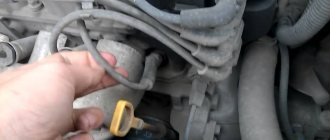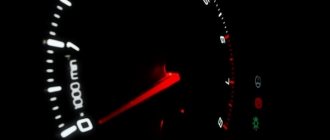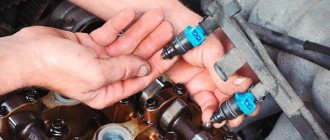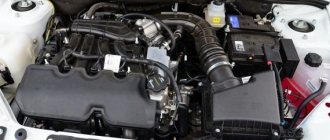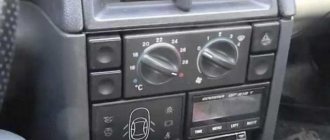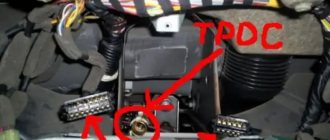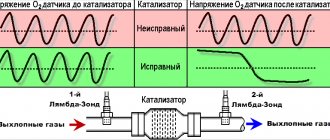Steering imbalance
Steering wheel vibration can occur due to wear on the tips and steering rods themselves. This effect can also occur when the steering rack play increases. You can make sure that this particular unit is worn out visually or by tugging the steering rods under the bottom of the car. They should not shake or move.
If there is vibration, this means that the unit must be changed, since at high speed even a slight deviation from the course can lead to an accident. The steering wheel of any car has free play. It is no more than 5 degrees. If this indicator is higher and is observed without movement, you must definitely contact a service center.
Engine mounts, tie rods and other problems
There is another group of problems that cause vibrations when accelerating a car. It is difficult to collect these problems into one bundle, because they are all different and arise for various reasons. Vibration often occurs when one of the engine mounts is broken. This can easily be checked by increasing the speed while shaking.
The gearbox may also be the culprit for this type of problem. If the car starts to shake at 80 kilometers per hour, you can very easily check the fault of the gearbox by performing the following procedures:
- accelerate to a speed of about 85 kilometers per hour;
- depress the clutch and observe the vibration change;
- engage third gear and smoothly release the clutch;
- try accelerating from 50-55 kilometers per hour in last gear.
If the nature of the shaking does not change in all these experiments, the box has nothing to do with this problem. If there is more shaking when the gearbox is engaged, you will have to check whether it is involved in this problem.
You can also check the automatic transmission. At a speed of about 85-90 kilometers per hour, it is enough to switch the gearbox selector to modes 3, 2, D, N and observe the operation of the box itself and the change in vibrations. Often the gearbox is not to blame for the vibration of the car body, but there are such cases.
Deformation on the wheel
Another cause of vibration is wheel deformation. The reason for this phenomenon is the threads of the court bursting in the tire. As a result, a “hernia” appears on the wheel, a small bump on the flat surface of the tire. It can be determined visually by inspecting the wheel.
It is impossible to eliminate such a malfunction; you just need to change the tire. A tire can burst at any time, because a “hernia” is the weakest point on a tire. A tire that bursts at high speed can lead to a complete loss of controllability and, as a consequence, an accident.
Steering wheel vibration
Steering wheel vibrations cannot be ignored. Otherwise, it is fraught with an accident. The steering wheel, like a litmus test, is the first to indicate a malfunction of the car control system. Here are the common causes of this problem.
- Wheel imbalance. Balancing is necessary so that each wheel rotates smoothly, without shifting the center of gravity. This problem is usually felt on smooth roads and at high speeds.
- Non-standard wheel size. When a motorist selects new wheels, it is extremely important to pay attention to the bolt pattern. For example, the value 4x98 indicates 4 holes for bolts and the distance between their centers is 98 mm. Some people believe that a couple of millimeters will not affect the ride quality. In fact, to install the disk, you will need to tighten the bolts at an angle. As a result, the wheel is installed offset. And at high speed the shaking becomes stronger.
- Worn shock absorbers or struts. The impaired smoothness of the shock absorber is also transmitted to the steering wheel. Old suspension elements become stiffer. Therefore, every unevenness feels like a big hole.
- The support bearing has failed. Due to the poor quality of the road surface, this suspension element quickly fails. If you do not replace it in a timely manner, it will negatively affect the serviceability of the entire shock-absorbing system of the car.
- Ball joints are faulty. Most often they become unusable due to the vehicle being used on bad roads. Therefore, in the territory of the post-Soviet space, the ball needs to be changed more often.
- Tie rod ends. If even a slight play appears when turning the steering wheel, it is necessary to replace the tie rod ends. They ensure parallel rotation of the front wheels. At high speeds, worn tips experience greater load due to the unequal arrangement of the wheels.
Here is another reason for steering wheel vibration:
What to do - the steering wheel shakes, the car shakes? Balancing didn't help...
Uneven tire pressure
Slight vibration at high speed may be due to unevenly distributed tire pressure. The reason for this phenomenon may be a puncture in one of the wheels or a bad nipple. A tire repair shop will help you fix the problem. You can check the difference in tire pressure using a hand-held pressure gauge, which every driver should have in his car.
If the tires are at low pressure, the tread pattern will be erased from the edges, and fuel consumption will increase significantly. If the tires are overinflated, the middle part of the tread wears out.
Another side effect is loss of controllability. On underinflated wheels, the steering wheel becomes “heavy”, which is especially dangerous in emergency situations. If there are more atmospheres than necessary, the braking distance increases, the car becomes more susceptible to drifts and drifts.
Where does this come from?
Vibration is a consequence of the action of centrifugal forces - a certain imbalance between the rotating components of the car - for example, between the engine flywheel and the crankshaft, a heater or radiator fan, drums and brake discs, a large difference in mass between the engine connecting rods and the piston system.
But what can cause car vibration or, in other words, imbalance?
- Technological reasons. They are most often caused by various deviations in the parameters and dimensions of parts.
- Design reasons are caused by the characteristics of a particular part. For example, on each of the wheels of a car there is a valve, which creates (albeit insignificant) deflection.
- Operational reasons are most often caused by severe deformation or wear of parts.
Damage to the internal parts of the hinge, which caused vibration, and this in turn led to the rupture of the engine mount.
Dirt sticking to the rim
Vehicle vibration may be a result of wheel imbalance. This is caused by dirt adhering to the rims. This is especially true in winter, when a large amount of dirt can freeze firmly to the metal surface of the rim. This problem is determined visually. Eliminated with hot water or visiting a car wash.
Problems that arise when wheels are unbalanced:
- danger of movement;
- wear of the steering unit;
- wear of the chassis and suspension.
The car shakes when accelerating
Vibration or shaking when accelerating a car can cause the most unpleasant sensations of discomfort in a car. The worst thing is when you count on rapid acceleration of the car (for example, to overtake a car), but when you press the gas pedal, you get in response, uneven acceleration with jerks.
In order to find out why the car shakes during acceleration, you need to check the following:
– Low oil level in the gearbox . Yes, a low level of transmission fluid can cause vibration and dips in the acceleration dynamics of the car when accelerating. Including, as a rule, when the oil level in the transmission is insufficient, jerks are observed during acceleration.
– The gearbox filter is clogged . A dirty automatic transmission filter can lead to vibration when accelerating the car. Replace the filter element with a new one yourself or at a car repair shop.
– Wear of the cardan joint . The U-joint on your driveshaft may wear out, causing it to shake or vibrate when you drive or pull away. This is especially obvious when accelerating a car. If the cause of the vibration is really the cardan joint, then do not delay replacing the part, because in the event of a complete breakdown, your car will not be able to move, which threatens with unnecessary expenses for evacuating the car to a car service center.
There can be a huge number of possible problems with a car, and a specific breakdown does not always give specific signs of its presence. Drivers often complain about body shaking when accelerating or at a certain speed. There can be quite a lot of problems that determine this indicator. If your car has vibration during acceleration, you should look at all possible breakdowns and immediately replace the failed components.
Transmission malfunction
A more serious problem can also cause your car to vibrate. For example, a faulty gearbox.
An additional way to diagnose this problem may be a number of other symptoms. For example, difficulties with turning on any speed or its constant loss.
With automatic transmissions, the faulty transmission will “kick” or jerk the car when shifting to the next gear. Driving with such a malfunction is dangerous, since the unit may fail while driving and then the car will have to be removed by a tow truck.
Vibration at speed
In addition to discomfort, vibration signals some malfunctions or improper installation of certain parts as a result of the last repair. The consequences of driving with vibration depend on which unit causes this effect, whether it is a consequence of a breakdown or the result of gradual wear of parts. For example, when the driveshaft crosspiece of some car models wears out, it creates a vibration that gradually intensifies.
To find out why vibration appears in the car, you can go for computer diagnostics. But this procedure does not always allow us to find out the true cause. We have selected some general recommendations from experienced motorists, thanks to which you can find the source of vibration without expensive diagnostic procedures.
Let's look at each of the symptoms that appear at a certain car speed.
0 km/h (idle speed)
The cause of vibration in this mode of vehicle operation may be:
- The gearshift lever vibrates, which may be caused by a misfire or tripping of the internal combustion engine (read why this happens in another review );
- The vibration is accompanied by a stable metallic knocking sound. The reason is wear and tear on the engine mounts;
- In addition to vibration, a high-frequency whistle can be heard from the engine compartment, especially in wet weather. The reason for this effect is the slipping of the generator drive belt;
- The car shakes a little evenly - the flywheel or clutch basket is unbalanced;
- If the vibration is uneven and periodic, then this may be a consequence of a misfire, problems with the fuel system or air supply, as well as malfunctions of the engine control unit.
0 km/h (high speed)
If the vibration frequency also increases as the speed increases, this may indicate a problem with the ignition system (the air-fuel mixture does not always ignite). You should also check the serviceability of the fuel system and the functionality of the control unit (for this you will need to perform computer diagnostics). Sometimes a similar effect occurs when the air filter is clogged or the air supply system is faulty.
Up to 40 km/h
In front-wheel drive cars, a crunching sound when turning the steering wheels indicates a failure of the grenade or CV joint. Also, any unnatural sounds coming from the steering wheels during maneuvering may be a signal of a breakdown of the steering mechanism, especially if this is accompanied by difficulty turning the steering wheel.
When vibration appears during movement after engaging a specific gear, this indicates a problem with the transmission. If vibration occurs when the gear is engaged (applies to cars with a manual or robotic transmission), and is also accompanied by a short crunching sound, then you should pay attention to the release bearing or clutch basket clutches.
40-60 km/h
Usually at this speed in rear-wheel drive cars, a malfunction of the driveshaft begins to appear (read about how to repair or replace this unit in a car in another article ), its crosspiece or outboard bearing.
The second thing you need to pay attention to is the unreliable fixation of the exhaust system. Also, some vibration at low speeds can be caused by a failed strut bearing (read more about the support bearing here ).
60-80 km/h
At these speeds, the brake system may malfunction. This malfunction will be accompanied by a characteristic sound. Additionally, you need to pay attention to tread wear ( in another review what problems are indicated by this or that type of tire wear).
Another reason for the appearance of vibrations at such a speed in a car is the imbalance of one of the rotating parts of the engine. A similar effect is also observed when the oil level in the automatic transmission housing is low or if the transmission oil filter is clogged.
80-100 km/h
In addition to the previously mentioned reasons, vibration in a car that accelerates to such a speed can cause minor wear and tear on suspension parts, such as ball joints.
100-120 km/h
If the engine is turbocharged, then the beating at this speed may be due to the fact that the turbine is not working correctly. The power unit does not receive the required amount of air, and therefore “chokes” from excess fuel. Vibrations in the car interior may be due to the fact that some plastic panels have shifted and are rattling.
More than 120 km/h
For vibration to form at such speeds, even minor deviations of aerodynamic properties from the norm are sufficient. To eliminate this effect, just install a spoiler. Thanks to this, additional downforce will act on the car. Read more about aerodynamics in another article .
Also, vibration at extreme speeds can be caused by the maximum torsional load of bearings that do not receive enough lubrication.
Brake disc runout
Car brake discs are made in such a way that over the years they wear out, that is, wear out.
Production on the disk occurs unevenly. At some point, one part of it becomes slightly thinner than the other. This leads to wheel imbalance and vibration. A chassis specialist can diagnose this problem by measuring the thickness of the entire disc.
It is possible to drive on worn out discs, but it is not recommended. After all, even slight vibration of the wheel gradually destroys the chassis components. It is advisable to replace worn out discs with new ones on all wheels at once.
Shaking starts at idle
It happens that the car begins to shake when accelerating, or vibration occurs when waiting for a traffic light. That is, the problem is observed precisely at idle speed.
There are 2 main reasons, the likelihood of which is the greatest. We will consider them.
It is important to add that similar phenomena characteristic of shaking at idle can also occur when driving. It doesn't really depend on whether everything happens in summer or winter.
What is vibration and how does a person feel it?
Vibration, according to definition, is the mechanical vibration of a solid body. It can be transmitted to a person through contact with him (tactilely) or through an audio channel. It is felt by a person through the organs of hearing, tactile or vestibular apparatus. The main parameters of vibration are frequency and amplitude of vibration.
Oscillation frequency is usually measured in Hertz. This is the number of vibrations per second. In a car, frequency is often measured in revolutions per minute. For example, 600 rpm. corresponds to a frequency of 600/60 = 10 Hertz, that is, 10 revolutions per second.
The human hearing organs respond to vibration frequencies from 20 Hz to 20,000 Hz. That is, a person does not perceive a frequency of 10 Hz with his hearing organs. This sound is called infrasound. A person feels it tactilely (tremor of human organs).
Infrasound at a certain frequency can cause a person to panic. This has been proven by numerous experiments. Animals flee in panic from earthquake sites as infrasound spreads across the ground in front of them.
Frequencies greater than 20 kilohertz are called ultrasound. Vibration at such a frequency is imperceptible to humans. But it can lead to significant damage to the components and mechanisms of the car. Therefore, during bench tests at factories, great attention is paid to the study of vibrations at these frequencies.
Video - possible causes of car vibration when driving at speeds of 80 km/h and above:
The amplitude of mechanical vibration is measured in units of length (millimeters, meters). Vibrations with an amplitude of a millimeter are not so noticeable for elements of the skin and body, but in bearings, for example, hubs, they can destroy it several kilometers away.
In the audio frequency range, vibration is measured in deciBels. The 0 dB level represents the limit of human hearing level. 150 dB is approximately the pain threshold for volume. A person perceives sound vibrations well at a level of 20 decibels.

